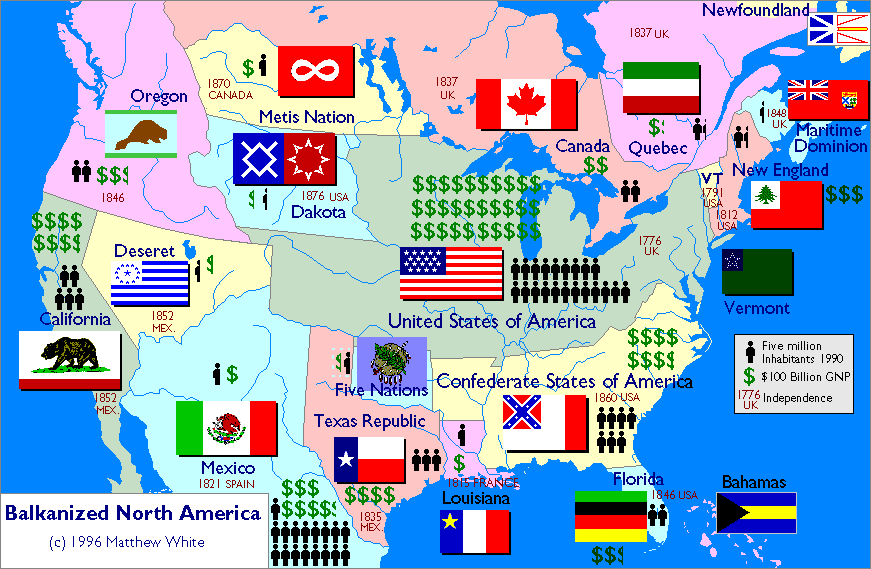Balkanized North America

What is the most fragmented that North America could have been? There are several plausible scenarios (some based on different patterns of settlement from Europe, others on different fracture lines) but I chose 1787 as the point of divergence from real history. In this alternate reality, the westward expansion of the Anglo-American people proceeded pretty much as it did in our reality, but the United States government just couldn't keep up. Every national identity crisis resolved itself in favor of the separatists instead.
Although this is an extremely unlikely scenario to begin with, I didn't want to just randomly subdivide the continent. I looked for regions which either ...
- administered themselves as autonomous nations at some point in American history, or ...
- shed blood to achieve or maintain their independence, or at least ...
- threatened to.
Of course, the Native American tribes throughout the continent fit all these criteria, but I limited myself to only three native enclaves.
Chronology:
1775-1783- The American Revolution procedes on schedule, and
the 13 colonies form the United States of America.
- 1787
- A fire at the State House in Philadelphia kills
several members of the Constitutional Convention, including
Washington, Madison and Franklin, and the new nation is forced to
pass its early turbulent years without its most important
leaders. After new delegates are chosen to replace the old ones,
the convention votes to scrap the constitution that was about to
be approved, and comes up with another one instead.
- 1791
- Annoyed at the way the new federal government under
John Adams is shaping up, Vermont refuses to join the Union,
declaring itself an independent republic instead.
- 1800
- France acquires Louisiana from Spain.
- 1803
- Annoyed at the way the USA under President Aaron Burr
is treating France, Napoleon refuses to sell Louisiana to them. Burr plans an invasion.
- 1804
- After President Burr is killed in a duel by Alexander
Hamilton, Vice-President Jefferson takes over, and the USA shifts
from a pro-British to a pro-French foreign policy.
- 1812-15
- The USA goes to War with Britain and
unsuccessfully invades Canada. In opposition to the war, New
England secedes, but Napoleon, grateful for the assistance,
agrees to sell the relatively empty Upper Louisiana to the US.
The area around New Orleans, however, has a large French
population by now, and it remains a French colony.
- 1815
- Refusing to recognize the restored Bourbon monarchy
of France, Lower Louisiana declares itself an independent
republic. A British force attacking New Orleans is slaughtered
by the defending French.
- 1819-37
- After many border incidents, the US occupies Florida.
Pockets of Seminole Indians and runaway slaves put up a stiff
resistance in Peninsular Florida, eventually driving out the Americans.
- 1820
- Without New England, the free states cannot get
enough votes to stop slavery from being allowed throughout Upper
Louisiana.
- 1821
- Mexico declares its independence from Spain.
- 1830
- The US expels the eastern Indian tribes to lands west of the Mississippi, settling them in what will later become the Five Nations area.
- 1835
- American settlers in Texas declare their independence
from Mexico. Louisiana intevenes because they are afraid that
Texas will join the USA if left on their own, which would leave
Louisiana utterly encircled. Cajun militia reinforces the Texans
at the Alamo, stops the Mexican Army and secures independence for
Texas, on the condition that it not join the USA.
- 1837
- The Mormons settle on the Great Salt Lake and found
the semi-autonomous state of Deseret within Mexican territory.
- 1837-41
- Rebellions in Quebec and Upper Canada establish independence from Great Britain.
- 1846
- American settlers in Oregon petition for annexation to the US, but the slave states vote the request down. Instead, the Oregonians establish a sovereign government themselves.
- 1849
- Gold is discovered in California. Immigrants from all over the world pour in.
- 1852
- Working in secret alliance, California and Deseret
declare their independence from Mexico, while Texas pushes its
border from the Nueces to the Rio Grande. Three armies (one from
each ally) converge on Santa Fe, but Mexico manages to beat back
these amatuer militias, holding onto New Mexico. Mexico, however, is forced to recognize the new nations.
- 1860
- Although the free state voting block had been
weakened by the secession of New England, the slave state voting
block had not been boosted by the addition of Texas, Louisiana
and Florida. As most of the new states carved out of Upper
Louisiana (Iowa, Kansas and Minnesota) had been settled by free-soilers, the southerners are only one state away from losing control of the Senate. The House of Representatives has already shifted to a free state majority, and with the election of Abraham Lincoln of the
abolitionist Republican Party to the presidency, the south fears
that slavery may soon be abolished altogether. The South secedes.
- 1861-63
- Lacking the manpower and industrial muscle of New
England, the USA fails to reconquer the South. In fact, New England is selling the CSA all the weapons it wants. Taking advantage of the crisis, the Five Nations of Indian Territory also declare their
independence from the USA.
- 1870-2
- Heavy-handed attempts by the Canadians to assert control over the interior provoke a revolt among the metis, the French/Native inhabitants of the Red River region.
- 1876
- Custer's command is wiped out by the Sioux and Cheyenne at the Little
Bighorn River.
Statistical Analysis
Last modified: November 12, 1996
© 1997 Matthew
White
Home

